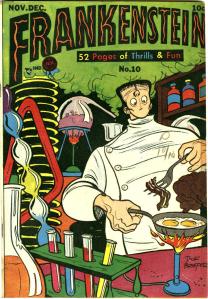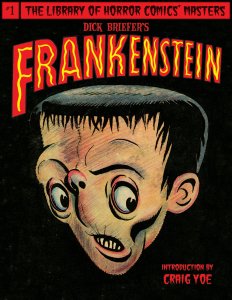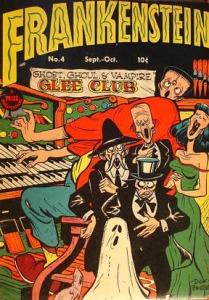Concerning Cucurbit Comics, or 57 Years of Hilariously Sincere Waiting for The Great Pumpkin.
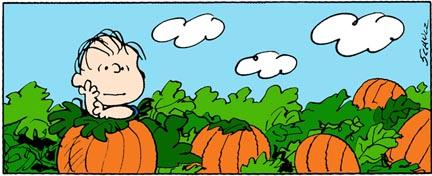
When Charles Schulz first devised his running holiday gags involving an eager child’s confused blending of Halloween and Christmas in October 1959, he never dreamed that the myth of the Great Pumpkin would become one of the most beloved and amusing elements of the Fall holidays. Like so many landmark Peanuts routines, what began as a simple joke about a seemingly quaint misunderstanding would eventually grow to sizable proportions throughout the decades, producing a number of memorable antics as well as some particularly pointed commentary on the values and risks of personal perseverance and popular scorn.
Five of the first seven “Great Pumpkin” strips reveal Linus Van Pelt spreading the joyful gospel that will eventually leave him humiliated as “a victim of false doctrine.”





From then on, Schulz deftly milked the joke every season, focusing mainly on Linus’ unsinkable faith in his own personal legend of a charitable pumpkin-claus who brings toys and treats to good little kiddos awaiting his arrival in the truest, most earnest, and sincere pumpkin patch nestled somewhere in the Great American breadbasket. Playing harbinger to his Halloween hero, Linus’ tone could shift from zealous and prophetic to desperate and dejected, but still he spoke his truth and believed always in his misfit vision of the holiday. Now his legend is ours as well.
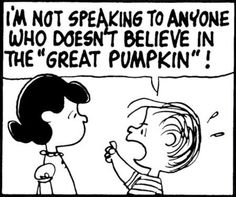





Of course the 1966 TV special, one of many award-winning adaptations that launched Schulz’s Peanuts gang to worldwide fame, would provide the most resonant and popular of all Great Pumpkin routines. Culled largely from the comic strips, and lovingly tweaked for television by Schulz himself and long-time producer, Bill Melendez, the CBS special, like its Christmas, Thanksgiving, and Easter counterparts, became a seminal element of American holiday media, and its yearly broadcast remains a beloved tradition shared by generations of viewers and fans. It’s safe to say that, ironically, much of the media-driven world now sits eagerly each year with Linus in his pumpkin patch.
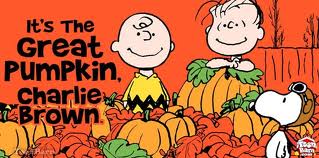

Like Schulz’s tree-eating kite, Charlie Brown and Lucy’s perennial football foibles, and the poor Peanuts kids’ eternal inability to win baseball games – Linus’ yearly disappointment after the Great Pumpkin’s failure to appear makes grand, operatic comedy of frustration and regret. Linus’ agony over another year wasted, his sister’s disgust at her little brother’s unshakable delusion, Snoopy’s perpetual knack for appearing at just the right time to give the poor languishing martyr some hope, and especially smitten Sally’s endless threats of litigation and restitution for a night’s worth of lost candy all frame the Great Pumpkin as a fairly piquant allegory of the complexities of faith, fun, and friendship in America.
Hand-Held Harlequins! : The Super-Humor of DC’s New Girl Powered Action Franchise
“Get your cape on, and let’s take flight! We can be who we like!” – DC Super Hero Girls theme song.
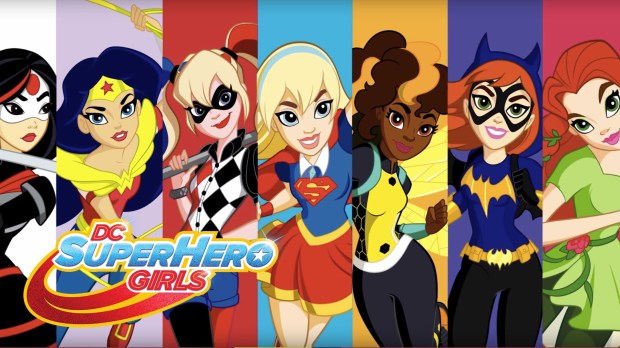
My daughter is a Caped Crusader.
Even in her toddler phase, she always preferred colorful costumes and cataclysmic combat over Barbification or Dora-mania. Yet, as far as we can tell from her second grade peers and pals, she is not a “geek” or a “mean girl.” She’s not a tomboy either, since prim princesses and personified ponies and adamantly American Girls and absolutely anything related to Alex Morgan all fill a good quotient of her 8-year old day. She does quite well in school, just completed her First Communion, plays two sports with aplomb, and has recently survived her first ear piercings, not to mention a fairly brutal soccer-smashed fibula.
Yet, when she really wants to cut loose and get her missy mojo working, she always turns to cosplay. Over the years, she has done turns as Super-girl, Maleficent, Frozen‘s Queen Elsa (Elsa is, ironically, her actual name!) and Leia Organa, but her more recent repertoire includes Batgirl, the Scarlet Witch, the Wasp, and most especially of late, Cat Woman and Agent Carter.
She is hardly alone among her age group in her inclinations toward super-couture, and believe it or not, neither Mom nor I have had much influence on her passionate attraction to wonder-duds. In fact, there isn’t much superhero merch about the house beyond my basement hobbit hole of a Media Studies library. Nor are we a particularly super-duper family, aside from fond memories of the original Super Friends and the occasional spontaneous viewings of The Incredibles or Big Hero 6. For further proof, just ask my 10 year-old son, who completely skipped over all of the superhero genres and contexts that fascinated many of his friends. From his earlest safaris around our home, he has always favored scouts, birding, tennis, and baseball. So super-stuff abides in our lives, but it does not beckon, inundate, or restrict our offspring’s access to other forms of generally pleasant and genuinely good-hearted American middle class fun. Still, on her own time and in her own mind, my daughter is definitely a Super Hero Girl.
Playing Drrrty Pool: A Few Reflections on Tim Miller’s Deadpool, Super-Humor, and its Discontents
In his 19 February review of Tim Miller’s Deadpool, Entertainment Weekly critic, Chris Nashawaty likens Hollywood’s current love affair with comic-book franchises to a “superhero-industrial complex.” Though the first adaptations of comic-book dash and drama had great promise, the entire enterprise has become “so monolithic and profitable” and flatly predictable that even die-hard fans of caped crusaders and marvelous mutants now shudder when expanded cross-overs, bloated sequels, and generic spin-offs are announced at Comic Con, the newly anointed Official Corporate Sphincter of mainstream Pop-aganda.

Eight years earlier, in the prescient and personal “Why I Hate Superheroes,” Nashawaty himself warned of the coming deluge of masked miscreants in his fond homage to pre-blockbuster “Nerdvana,” an earlier, innocent age when “no one had heard of Comic-Con yet and there were movies for everyone” during the season of big, brash air-conditioned escapism. That cogent, cautionary tale warned of the cultural fallout from the phenomenal success of Sam Raimi’s Spider-Man and its “endless 121 minutes” of “F/X eye candy” which “couldn’t have looked more bogus.” Nashawaty well knew, as did many others, that the prepackaged, high concept gloss of comic-book properties would soon admit ravenous Hollywood wolves into the fairly cultish, sheltered shires that were home to quaint communities of comics, cards, cosplay, and role playing fans: “It felt like every studio head in town, itching to wet his or her beak with Spider-Man’s box office backwash, was trotting out any half-baked comic-book flick that had been pitched across their desks: even the ones with C-list avengers like Daredevil, The Punisher, and Ghost Rider. No superhero was too minor or crappy to be pulled out of the mothballs, tarted up, slapped on the ass, and turned into a bloated summer movie.” In the annals of American culture, few harbingers have been as accurate in their dire predictions.
Now, in 2016, what the New York Times conceives as an “incessantly expanding comic book movie universe” shows absolutely no signs of slowing down its quantum mechanics. Some trends are truly exciting, especially in terms of comedy and humor. James Gunn’s goofy space oddity, Guardians of the Galaxy , ABC’s Agent Carter and Agents of S.H.I.E.L.D. , and even the CW’s Arrow and The Flash, Fox’s Gotham, and CBS’ Supergirl all offer a variety of fairly rewarding courses in caped comedy. Even dour concepts like Daredevil and the Punisher have been resuscitated and paired into one of the most anticipated Netflix series yet. Both Ant-Man and Aqua-man, hilariously satirized as fairly ridiculous properties by Nasthawaty in 2008, are well on their way to crowd-pleasing marquee magnetism, and we are bracing for the arrival of hordes of new super-flicks and costume-centered franchises well beyond 2018.
Magic Mindy: Kids Place Live, and the New Age of Children’s Radio Humor
“If something is really important, keep it in your underpants.” -Mindy Thomas, aka Absolutely Mindy, on Kids Place Live, Sirius XM
With all of the hyper-political parody and cunning satire currently churning through every jaded channel of irate idiot boxes and addled adult podcasts, perhaps its time to take a moment to appreciate a very different kind of humor that has been quietly, but quickly reshaping the way that many American kids and their families laugh, learn, and listen to the world around them.
Mindy Thomas, aka Absolutely Mindy, starring in the Recess Monkey video, “Flap Jacks”
Meet Mindy Thomas, the magnetic maestro behind Sirius XM’s Kids Place Live programming and the utterly enchanting spirit of early morning mayhem. As Absolutely Mindy, she helms the largely under-recognized Backseat Breakfast Club morning show on Sirius Channel 78.
The satellite radio industry has raised its fair share of eyebrows in recent years, with subscription fees, corporate mergers, and complex debates about markets and musical rights all tied to a medium that once represented the technological equivalent of free public speech. Now that the dust has settled somewhat, a number of exciting new outlets for all sorts of humor have arisen on a variety of satellite channels.
Among the most innovative and enjoyable of these forums is Kids Place Live, a channel devoted to family-friendly, G-rated kids programming that continues to surprise and delight with its frequently clever and often hilarious cast of affable characters and personalities.
More importantly, Kids Place Live has almost single-handedly inspired an explosion of diverse, dynamic children’s entertainment that rips through established genres and conventions with astonishing force. In fact, Kids Place Live has brought safe, fun, and rewarding radio back to children in ways that other interests, from Disney to NPR, could never quite muster. Not since the fabled days of The Lone Ranger, Little Orphan Annie, and Let’s Pretend has kids’ radio been so fun, loud, and different.
Mindy Thomas, Sirius’ perky princess of screwiness, is a revelation of light-hearted, pixie-dusted glee and her affable address to both kids and adults is laced with a beaming, witty joy that captures both the thrilling wonder and the insistent anarchy of childhood.
Billed on the Sirius website as “a carousel of non-stop nuttiness,” Mindy’s Backseat Breakfast Club has inspired a newly imagined community of young listeners and bemused parents nationwide. Beginning at 7 am, carloads of freshly caffeinated drivers and briskly brushed offspring tune in to Mindy, sharing those last precious minutes of freedom and frolic before harsh institutional realities come crashing down with the dreaded school drop-off or deadlocked morning commute.
Not all parents are fans, and that’s just fine, but there is no denying Mindy’s intimate understanding of what makes children smile. More often than not, she takes her kooky cues from kids’ own tastes and preferences. Potty humor and “Grosser than Gross” routines are common, but so are lengthy interviews with musicians, poets, and artists. Among her audience favorites are the outrageous “Birthday Missions” announced each morning in tandem with the Mission:Impossible theme and the “Breakfast Blasts Newscasts” featuring hilarious but relevant commentary from NPR’s Guy Raz. Frequent guest appearances by her own kids, tall tales about her mobile home loving parents, and outrageous tales of the misadventures of devoted hubby, Absolutely Mister, are all loaded with mirth and mayhem. To balance out the bedlam, the Absolutely Mindy Show also features its fair share of routine “healthy lifestyle” advice done up in wacky wrapping. These include Kira Willey’s “Seatbelt Yoga Breaks” and the always astute book reviews by Jarrett J. Krosoczka, author of the early readers’ Lunchlady graphic novel series.
Most importantly, though, Mindy and her media celebrate one primary theme: the limitless fun of Play. Calling on all listeners to mess around with everyday life as imaginatively and enthusiastically as possible, Absolutely Mindy constantly celebrates the multitude of benefits, inventions, and discoveries that arise from enjoying the world around us. She urges callers of all ages and listeners of every region to try new things, share wild adventures, and, even more frequently, admit to embarrassing fears, failures, and mistakes that may somehow limit their fun. Many of the most amusing stories from excited callers are accompanied by a background of adult groans, chuckles, and gasps. Of course, similar themes of fun and frantic comedy run through the shows hosted by Mindy’s collaborators, including Jack Forman’s Monkey House and Kenny Curtis’ neurotic menagerie, the Animal Farm. In fact, Lorenzo the haphephobic llama has become something of a super-star equal to Bugs Bunny, Sponge Bob, or Rainbow Dash in the eyes of my own children and their friends.

Music itself has changed thanks to Mindy and her maniacal crew. Screwball songs like Mike Phirman’s hilarious “Who Makes the Breakfast?”, Joe McDermott’s “Kitty Fight,” and Andrew & Polly’s ridiculously catchy “Grapes” are now as familiar and famous among the playgroup set as Katy Perry hits or Disney tunes.
Mike Phirman’s “Who Makes the Breakfast?”
Joe McDermott’s frantic “Kitty Fight” anthem
Andrew & Polly’s infectious “Grapes”
Sure, Frozen‘s “Let it Go!” and Vanilla Ice’s tepid Teenage Turtle anthem are constantly reiterated to the delight of gazillions of kid listeners, but so are charming tracks like Kristin Andreassen’s little known marvel, “Crayola Doesn’t Make a Color for Your Eyes” and Chris Rice’s “Billy Joe MacGuffrey.” Longtime star of the children’s charts, Laurie Berkner has hosted her own Kids Place Live feature as have the Aussie imports, the Wiggles. Dozens of wonderful new bands, acts, and comedians have found broad and eager new audiences through Kids Place Live’s lollapalooza of songs, games, and skits including the popular Story Pirates, who ‘steal” the concepts for their zany plays from submissions by child listeners. Among the most engaging musical offerings are bands like Lunch Money, The Pop Ups, Mista Cookie Jar, Jazzy Ash, and Joanie Leeds. Most importantly for my own family, though, Absolutely Mindy’s marvelous mixture of the eclectic and the iconic brought us all in touch with the remarkably fresh and environmentally empowering, Grammy-winning songs of the Okee Dokee Brothers, a goofy Bluegrass comedy duo whose rich folksy anthems have forever sealed our family’s commitment to getting outside and explore the natural wonders of the nation.
Kristin Andreassen’s “Crayola Doesn’t Make a Color For Your Eyes”
Chris Rice’s full length epic, “Billy Joe McGuffrey”
The Okee Dokee Brothers’ river anthem, “Can You Canoe?”
The Okee Dokee Brothers’ revisit an American classic, “Haul Away Joe”
The Okee Dokee Brothers’ “Walking with Spring”
Mindy’s circus of sound, speech, and song on Kids Place Live might not delight every parent with its raucous address. The Backseat Breakfast Club will not speak to those adults who are too entwined within the sour spin machine of Bill Maher/Jamie Oliver/Stephen Colbert/Jon Stewart, or whatever splendorous smarm Andy Cohen and Jimmy Fallon hover over at the moment. What it does do, however, is keep us interested in the endless potential of childhood fun, wonder, and happiness. When so much contemporary comedy is as factional, contentious, and combative as can be, the Absolutely Mindy Show is alive with mischievous innocence and family-focused frenzy. Now, that’s magic well worth keeping in your underpants!
Tricky Treats and Goofy Ghosts: A Halloween Harvest of Hilarious All Ages Graphic Novels
Welcome to the last night of summer and the first early smidgens of impending Autumnal Awesome!
Though I previously promised a very different type of post for my next HA! installment, I just can’t help celebrating the comedy of the season with a short list of little known works that brim with big laughs for all ages.
Fall remains a grand season of bountiful mirth, bemused reflection, crisp comedy, and pumpkin-sized parody, but the past few years have provided us with an impressive harvest of wit, wonder, humor, and hilarity all keyed to the themes of darkening nights, kiddie creatures, and whimsical witchery.
So pull up a comfy cucurbit and let’s dive into our cornucopia of comedy!
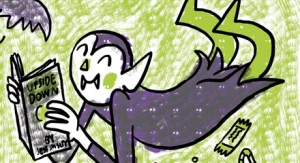
1. The Itty Bitty Hellboy series : Mike Mignola, Art Baltazar, & Franco
Mike Mignola’s signature creation, the fearsome Hellboy hybrid, has brought slick new wit to the Superhero, World War II, and Ghost Story genres. Horror maestro, Guillermo Del Toro, has developed an intriguing big budget franchise out of Mignola’s B.P.R.D. milieu. (That’s Bureau of Paranormal Research and Defense for those folks who thought that S.H.I.E.L.D.’s acronym wasn’t ridiculous enough.) The best elements of Mignola’s action-packed adventures revolve around the self-conscious humor he meticulously weaves into nearly every stitch of his narrative tapestry. From Hellboy’s irreverent asides to Mignola’s own sly satires on overblown pulp tropes like the NAZI-abetted apocalypse, each page of the grown-up Hellboy glows with freaky fun.
Sadly though, the little ones can’t share in most of these adventures.
Even better than the originals, and much more enjoyable for all ages, are the Itty Bitty Hellboy lampoons that remix Mignola’s grim, shadowy realms to the rhythms of Little Archie and the Muppet Babies. The results are, quite simply, hysterical. The B.P.R.D.’s chilling creepitude crashes into the endearing cuteness of Baltazar and Franco’s winning make-overs for each character. The adventures are, of course, equally playful and parodic, with enough running gags and adult allusions to amuse every level of literacy.
Baltazar and Franco have enjoyed success with a variety of cutesified comics properties especially their Tiny Titans tales, but these diminutive heroes lack the added hellish ironies that Itty Bitty Hellboy piles onto its bonfire of crackling comedy. Two kooky collections are currently available, with more stories set to appear in the not-too-distant future. Hell and damnation have never been quite so delightful!
2. Jess Smart Smiley’s Upside Down Series
As adorable as an infantilized hellspawn might seem, l’il Hellboy has nothing on Jess Smart Smiley’s Harold, the little vampire with an unquenchable sweet tooth. Designed with clean, free-lined freshness, Harold’s slapstick adventures explore the more mundane elements of vampire life alongside a supporting cast of mad disco doctors, friendly familiars, and whimsical witches. The aptly named Smiley brings rich new warmth and much needed ingenuity to a genre long overloaded with literally half-dead riffs on the worn-out Addams Family tradition. More honest, joyful, and stylish than the swath of Wimpy Kids and Dork Diaries that inundate early readers catalogs, the Upside Down stories are deftly designed, gleeful parables of screwball spontaneity.
Smiley is at his best articulating moment by moment physical comedy, and the quirky blocking only gets better when his creatures converse casually from obtuse angles, or upside down (of course), sharing the everyday concerns of young monsters and eager little undead. Like Itty Bitty Hellboy, two splendid collections currently prowl across the internet’s e-stalls, but we are hopeful that more of Harold’s hi-jinks will chase bleaker clichés away from of our Halloween hootenanny.
3. Melvin Monster by John Stanley
Sometimes old school monsters are the most amusing of all, and John Stanley’s joyfully hideous creation, Melvin Monster, remains as tightly structured, sharply satiric, and outrageously funny as he when he first appeared in 1965. Thankfully, the lauded publisher, Drawn & Quarterly, cut no corners in its loving three volume treasury of resurrected reprints that bring Melvin back from beyond with more grandeur and gusto than he ever received in his own era.
Please don’t confuse Stanley’s mini-monster masterpiece with the earlier Atlas Comics creation, Melvin THE Monster, a juvenile delinquent developed by Stan Lee and Joe Maneely to cash in on the popularity of Hank Ketcham’s Dennis the Menace. On the contrary, Stanley’s Melvin never wreaks havoc directly, but rather as a side effect of his tender regard for the world he so loves to explore and entertain. He struggles at the Little Black Schoolhouse with the demanding Ms. McGargoyle, strives to gain the approval of his doting Mummy and Baddy, and tends tirelessly to his pet crocodile whose poor track record as a reptilian predator is equaled only by Steven Pastis’ hapless “Brudderhood of Zeeba Zeeba Eata.”
Stanley himself was an unsung master of withering mid-century domestic satire and his contributions to Marge’s Little Lulu, Kookie, Thirteen (Going on Eighteen), the latter day re-launch of George Herriman’s Krazy Kat, and (Around the Block with) Dunc and Loo remain classics of the Dell “All Ages” brand. Yet, Stanley was also a serious student of the chiller, and his few excursions into Gothic mystery included some of the most surprising spine-tinglers of the post-code era. His two ghoulish Dell anthologies, Ghost Stories and Tales from the Tomb, are now considered landmarks of originality, and remain even more fascinating for their shrewd use of gripping but bloodless tension and shock. For Melvin Monster though, Stanley brought the perverse charms of grotesque innocence to an otherwise prescribed and tiresome adult world of rules, obligations, and harassments. Melvin’s misadventures, now handsomely revamped for millennial readers, reveal how his simple fascination with all of the world’s great thrills make him the most magnanimous monster in the history of kiddie comics.
4. Scary Godmother by Jill Thompson
Like Stanley’s monstrous Melvin, Jill Thompson’s incredibly clever Scary Godmother concept has never garnered the mainstream success it so sorely deserves. Hokey Halloween mash-ups are now legion and while some become the stuff of pop legend, destined to ride alongside mainstays like the Headless Hessian and The Great Pumpkins, most get tossed back into the Mad, Mad Monster Party with the rest of the vapid vampires and franken-flops. From Scooby-Doo to Monster High, the family friendly fascination with villainy, monstrosity, and sorcery seems timeless, but there really has never been anything quite like Thompson’s Scary Godmother before.
Equal parts Mary Poppins, The Cat in the Hat, and Harry Potter, Scary Godmother and her “broommates” from The Fright Side are deliciously original extrapolations of a thousand Halloweeny myths and rituals. Even better, every single one of them bristles with fun allusions to their antecedents. There’s Harry the chatterbox werewolf, Maxwell and Ruby the glamorous vampire couple, and their Emo/Goth offspring, Orson, an enfant terrible named, of course, after the original Halloween mass media prankster.
Then there are the intrepid kid heroes whose good natured collaborations are just as enjoyable as the classic gang comedy of the Mystery Machine crew. Scary Godmother is probably the most commercially successful of the works profiled here. It has enjoyed multiple comics series, graphic novels, collections, and children’s books, as well as reasonable success with animated adaptations, but these never really capture Thompson’s richly rendered watercolors. As a mass media franchise, Scary Godmother is a fun and rewarding curiosity, but its original sequential habitat explodes with abundant Halloween humor. Tim Burton and Neil Gaiman (a friend and frequent collaborator with Thompson) should both grind their fangs with a bit of jealousy. They may rule the darker realms of sinister sorcery, but what Thompson brings to light is bright, brilliant magic.
The complete Scary Godmother Halloween Spooktacular is available here.
5. Frankenstein by Dick Briefer
Let’s conclude with a classic Halloween creature, the infamous Frankenstein monster – though not quite as fearsomely familiar as he may seem. James Whale’s campy Frankenstein franchise at Universal kicked off something of a fad for Modernist monsters and Franken-themed commodities. There were, of course, midnight double features with Browning’s Dracula, and numerous pulp reprintings of Mary W. Shelley’s perennially popular thriller, as well as Marvel and Classics Illustrated adaptations in the “Golden Age” of comics.


At the same time, the intrepid Dick Briefer, a seasoned cartoonist of various genres, introduced a new feature in the 1940 Prize Comics anthology title adapting the tale with elements culled from both Shelley and Whale. These early “monster” stories – developed by Briefer but credited to “Frank N. Stein” – are Expressionistic and raw, with a Karloff-esque creature rampaging through contemporary cityscapes to brutalize authorities, gangsters, and circus animals alike. He is, in effect, a kind of anti-Superman or proto-Hulk, impossibly strong and ferociously driven by rage and fury. Before long, however, a monstrous miracle would occur.
Over time, Briefer’s sense of the Absurd would fashion Shelley’s creature into the neo-gothic equivalent of Jack Benny and his hearty cohort of peculiar pals. In these stories, Franky’s monstrous bulk would become the fodder for endless slapstick. sight gags, and clowny costume changes ranging from superhero suits to Viking gear and elephant trunks. Throughout the late 1940s, Briefer’s gleeful deconstructions of American horror’s most recognizable monster spoke to changing times and subversive tastes. His screwy sketches are overloaded with puns, pratfalls, and parodies of multiple genres as well as, at times, self-conscious satire of the very art of cartooning itself. Akin to the most irascible work of Harvey Kurtzman, Will Elder, and Rube Goldberg, the heyday of Briefer’s humorous Franken-jester was cut short by market changes. To cash in on the crass horror craze of the mid-1950s, Briefer once more remodeled his monster into an even more terrible scourge, but the wacky middle phase of madcap pastiche would presage the coming of other Gothic comedies like the Addams Family, the Munsters, and to some extent, even glam-camp spectacles like Rocky Horror.
The majority of Briefer’s Frankenstein oeuvre is now more available than ever before in multiple collections and archival editions. Our national humor and our Halloween holidays are all the better for it!
Until next time, humorous hauntings everyone!
50 Ways to Play!: Selected Sex Positive Responses to the Agony and Ignomy of “Torture Porn” Romance
Somewhere amidst all of the Superbowl spectacle, Valentine’s spooning, St Patrick’s Day carousing, Passover reflection, V-Day agitation, and Lenten abstention, a strange and somewhat sleazy new trend reached its zenith, crested, and then settled down to a steady, new buzz within our national pysche. This slightly awkward, insistently uncomfortable climax was, of course, the highly engorged premiere, ritual critical circumcision, and premature box office depletion of Sam Taylor-Johnson’s Hollywood adaptation of the opening rounds of E.L James’ titillating trilogy of triage, 50 Shades of Grey.
Though the film opened to sold-out shows on that raciest of all holiday weekends, The Guardian has more or less summed up its econo-sexual stamina down the stretch: “Dramatic plunges from its opening weekend – -73% in the US (one of the largest falls on record) and -57% overseas – suggest that it has already exhausted its core audience, the EL James faithful, let alone any casuals pulled in by the furor… Prospects-wise, Fifty Shades is no Avatar, which did a game-changing six consecutive $100+ overseas weekends – this is strict box-office wham-bam-thank-you-sir.” In short, Fifty Shades will probably come to signify the most high profile case in a very familiar syndrome that plagues America’s reactions to the uses of explicit sexuality and erotica in entertainments of all sorts.
The fact that 50 Shades – a sadomasochistic fantasy rooted in the “therapeutic” cruelty of an enigmatic, aloof tycoon and his sweet, little ingenue-cum-whipping post – has commanded such attention in all of its forms is fascinating, sensational, and like most such phenomena, a little bit sad.
Now, please don’t grab the ball-gag yet. It’s not that I disapprove of anything as exciting as a randy trilogy of explicit sexcapades that has somehow infiltrated the shelves of every major warehouse store, supermarket, airport stationer, and nightstand in the nation. Quite to the contrary, as Leslie Bennetts observes in her Entertainment Weekly feature on the 50 Shades phenomenon, “None of us will ever know how many orgasms Fifty Shades of Grey has inspired, or how much marital boredom it’s enlivened with vaginal balls and riding crops, but its impact is incalculable far beyond the bedroom.” Far be it from me to poo-poo anything that has so vehemently and profitably fueled the free world’s sex drive. Again, Bennetts provides us with some startling numbers: “Since the first volume of E L James’ S&M trilogy was published in 2011, the books have sold more than 100 million copies worldwide and been translated into 52 languages. From the Bible to the Harry Potter series, only a handful of books have ever racked up such numbers, and no previous work of pornography has captured the erotic imagination of so many women.”
There has been more than enough curmudgeonly commentary, critique, and conflict revolving around both James’ pseudo-Sado-fiction and Taylor-Johnson’s darkly lit film. Quite honestly, the segments I read from James’ work do their job as adequately as any other artifact of arousal probably should. If you push the right narrative buttons involving suggestion, anticipation, and seduction, in nearly any order, the usual explosive results are pretty much inevitable. Or as as EW’s Lisa Schwartzbaum observes, “James may not be much of a prose stylist, but she can write an effectively dirty, hot, easy-to-read, complicated-to-accessorize sex scene when she puts her mind to it. James throws in descriptions of bondage, submission, foreplay, cosmic orgasms, private helicopters, and fine white wine. And minus the boring bits about private helicopters and tedious wine -sipping, it’s all tatty, arousing fun.” I also admit that I have not yet seen the now largely panned film adaptation, though I will probably give it a go eons after its original shock have faded through Sisyphean runs on late night cable.
I have no qualm or quarrel with the book that launched a tsunami of coital clashes, or the movie that looks like it does its best to somehow make romance out of punishing, joyless, sexual violence. No, my gripe has nothing to do with 50 Shades‘ explicitness, triteness, or brutality, though I generally prefer more actual pleasure in my private reading and personal media consumption. I am more disappointed in the simple fact that every authorized rendition of the dirty dalliances of Mr. Grey and Ms. Steele seems to lack any iota of (intentional) humor, joy, or playfulness. With all of that role play, kinky couture, and so very many scandalous props and toys, shouldn’t there be at least one non-literal gag to enjoy? Wouldn’t some part of James’ great teasing Trilogy of Tight-Knottedness celebrate the incredibly transgressive, inscrutable, unstoppable FUN of sexual experiment and erotic excitement?
Where are the farcical phallic jokes? The sloppy puns? The slippery entendres and sassy pillow talks? Where, for heaven’s sake, is the great comedy of busy bodies falling across each other in exciting ridiculous ways? We don’t really seem to mind what’s missing either. Instead of getting hot and bothered by great sex between good people, readers and audiences are more entranced by a stiff (groaning pun intended) and icy erotic aesthetic that might be best classified as “Brain Dead Sexy.” Where is the sex farce and satyr play? Where are the May Day mummers and hot-blooded courtesans? Couldn’t Anastasia find better, more vibrant, and more virile company at Ridgemont High and wouldn’t Sob Sister Christian find riskier business during a quick power lunch at Porky’s? More importantly, wouldn’t we all?
For the time being, 50 Shades of Grey has brought sexually intimate fiction, erotically charged art, and “pervy” non-normative forms of sexual activity and exploration into the mainstream. If there is any greater “good” that could arise from Mr. Grey’s holsters, harnesses, and harangues, it is probably the widespread lessening of our national provincialism, righteous rigidity, and pervasive hypocrisy concerning the role that sexual pleasure, erotic performance, and perverse fetishes may have in our culture and our lives. But shouldn’t humor play a leading part in that voluptuous victory of good clean vice over venal virtue? Don’t we need the aggression and anarchy of comedy to satisfy our healthy sexual hungers? Whither wag our winsome willies and why do we seem to prefer them when they are locked away in Castle Greyskull or grimly sheathed in Steele? Wouldn’t it be more fun for everyone involved to just share the warmth of some good old fashioned American cherry, apple, or banana cream pie?
Charlie and Louie: An Affair of Two Magazines, Two Cities, and Too Many Questions
Je suis Charlie Hebdo, et aussi Michel Brown, et aussi Darren Wilson et aussi… As Teresa Prados-Torreira recently observed in this space, the last month has seen an international slurry of reactions to the Charlie Hebdo Massacre from outraged officials, scampering journalists, erstwhile academics, dedicated peace-keepers, and, of course, the international community of artists, cartoonists, and satirists. Prados-Torreira astutely summarizes in her 20 January post, “at first glance, it seems obvious that the answer to this dilemma should be a wholehearted affirmation of the need to stand in solidarity with the French magazine, with the murdered cartoonists, and in support of free speech. But the content of Charlie Hebdo’s cartoons, their irreverent depiction of Mohammed and Muslims, have resulted in a cascade of critical essays online and elsewhere.”
Many have since noted that, for interpreters within and beyond French culture, the magazine’s scabrous treatment of all things sacred and sanctified could be labelled either courageous or irresponsible depending upon personal preference. One thing is certain, though, Charlie Hebdo was rarely, if ever, about discretion. Even more interestingly, a new angle on the extensive media coverage of the attacks has taken shape that inquires as to why the tragic murder of several talented artists has become, either incidentally or on purpose, a larger global issue and a much more public and popular rallying point than the rampant cruelties taking place in Nigeria involving Boko Haram?
Even more interestingly, we have to admit that slander, satire, and ridicule of Arabs, Muslims, and Islam are hardly rare in America mainstream culture. Consider the skirmishes that erupted over the years surrounding Johnny Hart’s abuse of Islamic and Judaic symbols in several episodes of his comic strip, B.C., especially the “potty humor” episode that fused the sacred icons of Islam with the half-moon of an outhouse door. Is this not Charlie Hebdo territory? With the rhetorical avalanche surrounding Charlie Hebdo just beginning to settle, we might wonder if any more discussion could possibly serve to alleviate the tension, fear, and uncertainty that has seemingly spread across an outraged global public.
It’s a very fair question, but instead, I would like use the terror attacks in France, and their subsequent influence, to explore a few more local and personal concerns about the deploying of satire, the power of cartoons, and the often unexpected inaccuracies of visual wit. Since the assault on the Charlie Hebdo offices, there have been several inspiring statements of solidarity and strength in support of free speech and equal opportunity insult, most notably including the great public demonstrations in Paris, throughout France, and across the world.
Can there ever be a more heartening and honest sign that humor – especially in its most relentless, hostile form – deserves our attention, respect, and scrutiny? There have also been a wide variety of high profile reactions and commentaries throughout the intellectual honeycomb of bloggers, critics, and scholars. Much has been made of Joe Sacco’s somewhat disappointing Guardian catechism “On Satire.” Important statements have also arisen from doyens of provocative comics including Art Spiegelman, Keith Knight (who produced two suitably irreverent texts from very different perspectives), and Steve Benson, among many, many others. Scholars also have contributed valuable and sometimes revelatory insight into the complex legacy of French cartooning and its contribution to both Charlie Hebdo’s editorial policies and the violent reactions that it frequently instigated. Bart Beaty and Mark McKinney have offered reasoned and informative assessments that went largely ignored in the media frenzy following the attacks. Even richer and more comprehensive studies of the violent potential of editorial cartooning have also arisen from astute historians like Paul Tumey and Jeffrey Trexler. Cartoonists, of course, have been at the vanguard of the fight for freedom of speech, recognition, and reaction. From the very moment that news of the attack broke in France, powerful responses like this one were quickly finding their way around the world’s webs.

The translation is simply, “The ducks will always fly higher than the guns.” This seems a fitting commentary on everyone’s natural right to free speech, peaceful tolerance, and artistic expression but for the French reader, as I have come to understand it, the cartoon also includes sly references to the enduring poignancy of journalism and the relative pointlessness of murder, terror, censorship, and repression. As far as I know, this cartoon comes from the first wave of responses to the assault on the Charlie Hebdo offices.
Opossum Carols, or Walt Kelly’s Xmas Postludicrosity
As the first snows of December drift across my South St Louis windows, and the last shards of Thanksgiving turkey find their way into the requisite casseroles, cold cuts, and cauldrons of stock, I find myself harkening back to early Advent Sundays of yore.
My childhood, like so many others, was loaded with the humor of the holidays, but one of my family’s favorite traditions always tended in a more marsupial direction. So if you’ie got some time between mixing tubs of “Tom and Jerry” and trimming the tree, I’d like to share one of many meaningful excursions through the absurd quadrants of kiddie Christmas culture.

As I boy growing up in Detroit in the 1970s, I loved watching my mother collapse the last of her gargantuan Thanksgiving feast into a few impossibly crammed Tupperware containers and stuff the serving platters, gravy boats, and silver-plate cutlery away for their long sleep through the seasons until the following November.
While my father wrestled with the Christmas tree and cursed our cat as it grinned Cheshire-style from the upper branches, my mother would softly sing carols to herself or hum along to the holiday classics on the kitchen radio. My family loved Christmas for many reasons – togetherness, food, faith, and even frantic shopping – but mostly we adored the way it gave rise to an unusual number of opportunities for great stories and copious laughter. Those post-Thanksgiving radio carols were our first inklings that more manic Christmas cheer would soon come rolling in on an eggnog tsunami of tinsel, gingerbread, Grinches, and Good Old Charlie Brown holiday specials.
Every year, though, one particular tune ran a bit askew of the more traditional standards. My mother was hardly a musical person. She could never carry a tune and she famously celebrated the destruction of our family piano, relishing the thought that she had saved her son from the miserable lessons she detested as a child. Yet, she loved Christmas music of all stripes, and one particularly eclectic ditty above all else.




















